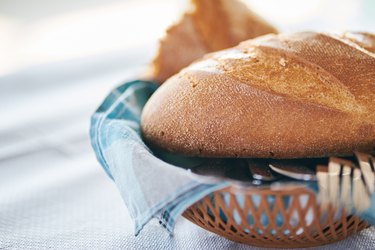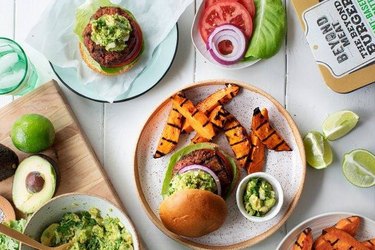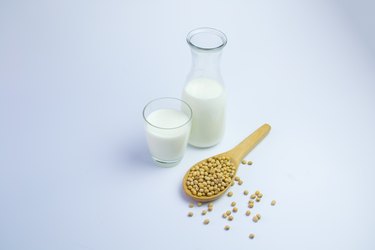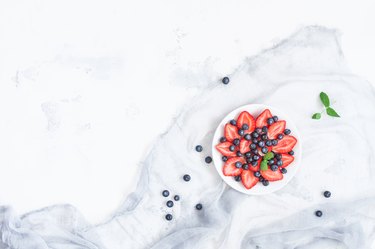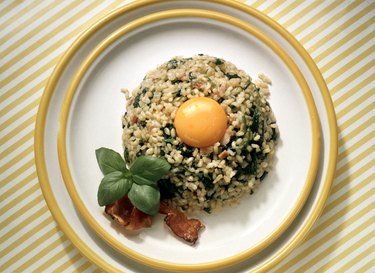
Gluten- and dairy-free menu ideas don't have to be complicated, expensive or time-consuming to prepare. However, a bit of advance planning is required if you want to create simple, healthy meals that address your dairy or gluten intolerance as well as your everyday diet and weight-loss goals.
Avoiding your personal trigger foods can be challenging, because dairy products and the grains that contain the protein gluten — including rye, barley and wheat — are extremely common in the American diet. However, if you're willing to give it some forethought, you can come up with plenty of gluten- and dairy-free options to enjoy for breakfast, lunch, dinner and snack time.
Video of the Day
Video of the Day
Food Sensitivity Symptoms
As you have probably learned firsthand, gluten intolerance is a food sensitivity that can wreak havoc on your digestive tract, resulting in symptoms such as diarrhea, bloating and flatulence, as described by the Cleveland Clinic. Lactose intolerance has similar unpleasant symptoms, per the Mayo Clinic. If you are experiencing digestive issues, talk to your doctor or nutritionist for help determining the cause. He or she will also have ideas on foods you can eat safely.
Gluten-Free Carbs for Breakfast
Many people eat carbs for breakfast to give themselves energy to start the day. But wheat, rye, barley, malt and brewer's yeast all contain gluten, so carb lovers who want to go gluten-free will need to choose baked goods made with other grains.
Finding bread and bagels that are both gluten- and dairy-free is a challenge, but options do exist. Choose bread made with gluten-free grains such as rice, flax, amaranth, corn, millet or ground nuts, seeds or soy.
Breakfast on a gluten- and dairy-free diet could consist of eggs scrambled with water or calcium-fortified plant milk, a piece of fruit and a slice of gluten-free toast spread with coconut oil, sugar-free fruit preserves or nut butter instead of dairy butter.
Fried potatoes are another carbohydrate-rich breakfast food that is gluten-free. For a change, try cooking up carb-rich plantains, which are starchy relatives of bananas.
Oatmeal and granola are two other delicious, carb-rich breakfast foods. Oats are naturally gluten-free, but as the Celiac Disease Foundation (CDF) points out, "cross-contact can occur in the field when oats are grown side-by-side with wheat." Therefore, they advise that those who are avoiding gluten choose breakfast cereals and other oat products that are specifically labeled "gluten-free."
"There are many food items that may contain gluten, often in hidden or unexpected ways," cautions the CDF. "Always read the label of any food product you buy if 'gluten-free' is not specified on the label."
Fruits and Vegetables for Lunch
For an easy-to-fix dairy-free lunch, try a plate of dark, leafy salad greens topped with canned salmon, cooked white beans and plenty of vegetables such as chopped tomatoes and cucumbers, grated carrots, diced onions and steamed broccoli or asparagus.
For maximum calcium — which you may need if you go dairy-free — eat the small bones in the salmon and incorporate calcium-rich greens like kale into the salad mix. Steer clear of croutons, imitation bacon bits and commercial salad dressings, all of which may contain gluten. Instead, prepare your own heart-healthy dressing using distilled vinegar, spices or herbs and a monounsaturated oil such olive oil.
A platter of fresh fruit is certain to be both gluten- and dairy-free, as well as a good lunch choice for weight-loss. Instead of serving the fruit with cream (a dairy product), consider topping it with a drizzle of honey or a shake of cinnamon.
Make Snacks Count
A piece of fruit plus a handful of nuts or seeds is a great snack choice at any time of day. Other healthy snack choices that are gluten- and dairy-free include:
- plain popcorn tossed with olive oil and your choice of spices or herbs,
- rice cakes spread with nut butter, or
- a bean dip such as hummus served with rice crackers or raw vegetables.
Lean Proteins for Dinner
A simple but nutritious gluten- and dairy-free dinner might include grilled steak paired with cooked quinoa or brown rice, steamed vegetables and a dessert of fresh fruit. You can avoid excess saturated fat, cholesterol, sodium and calories by choosing lean cuts of beef or pork, skinless poultry and seafood over fattier cuts or processed meats.
Cook grains like quinoa or rice in water instead of commercial stock or broth that may be prepared with ingredients containing gluten. By including leafy greens like bok choy, collards or turnip greens in your vegetable rotation, you'll ensure that you get plenty of calcium to make up for the lack of dairy in your diet.
Eggs and meats — including bacon, fish and sausage — are all gluten-free protein sources that you can eat for breakfast, lunch or dinner. However, some processed meats do contain dairy, in the form of the milk protein known as casein. Read food labels carefully for casein as well as for any mention of "hydrolyzed vegetable proteins," which might indicate that the product contains gluten.
"Non-dairy definitely does not mean that the product is milk-free," warns the Food Allergy Research and Resource Program at the University of Nebraska–Lincoln. "FDA regulations specifically allow the use of caseinates (and casein is one of the major milk allergens) in non-dairy products. However, the term 'caseinate' will appear in the ingredient statement and must be followed by a parenthetical explanation, such as (a milk derivative). While non-dairy is a term that is frequently used on coffee creamers, it is also used similarly on various other products containing caseinates. Once again, careful inspection of the ingredient statement is the consumer's best defense."

